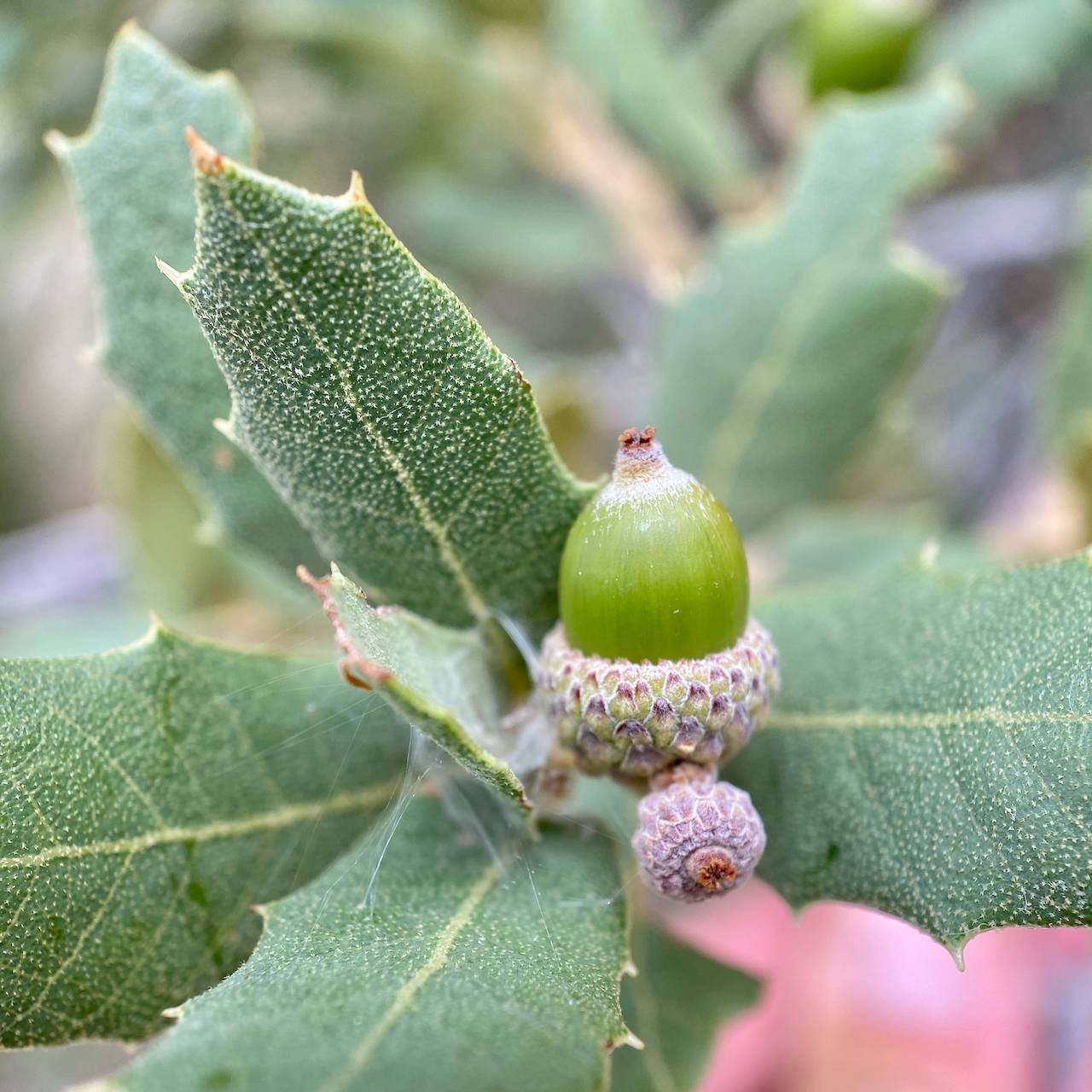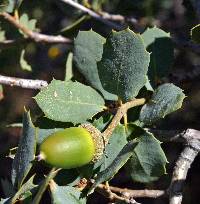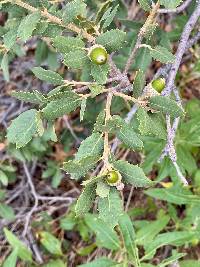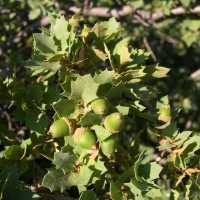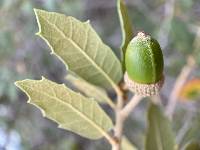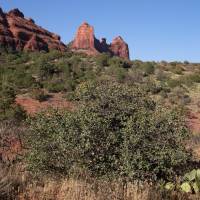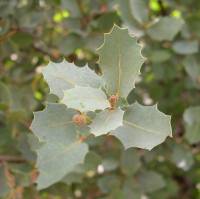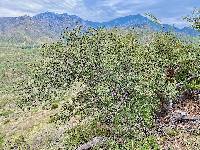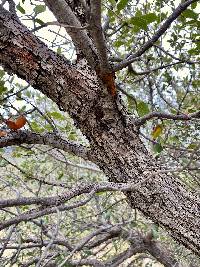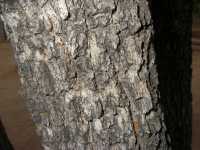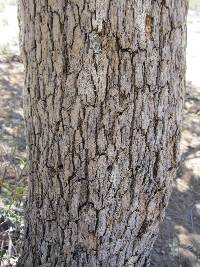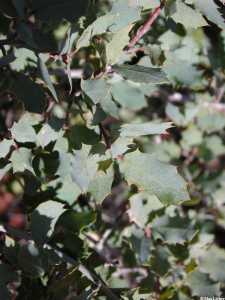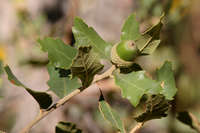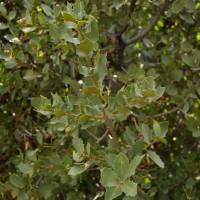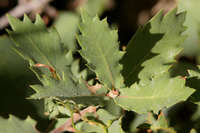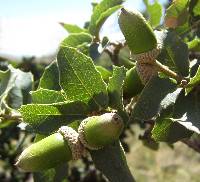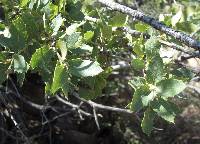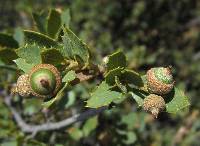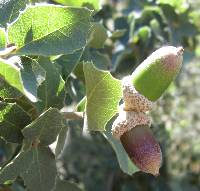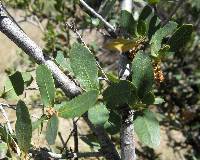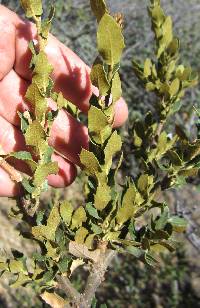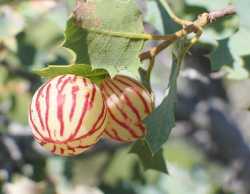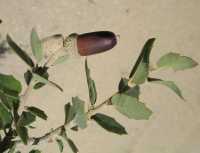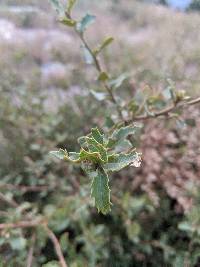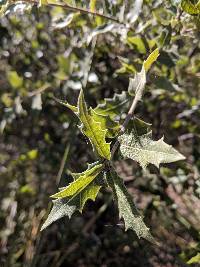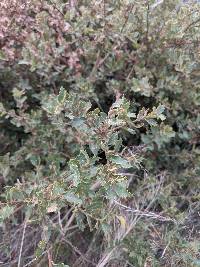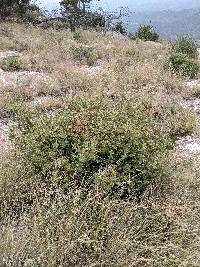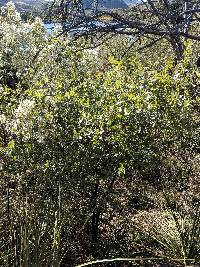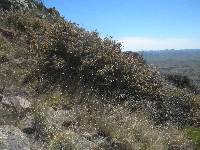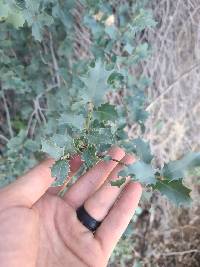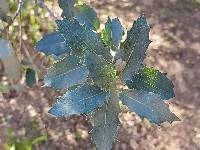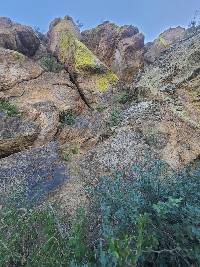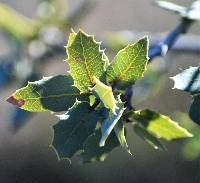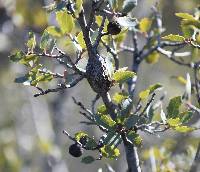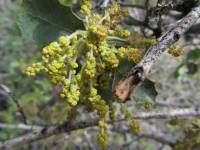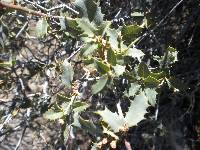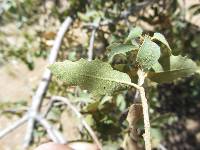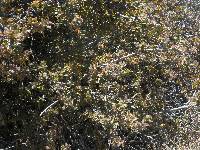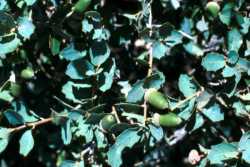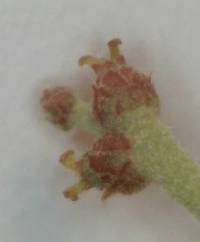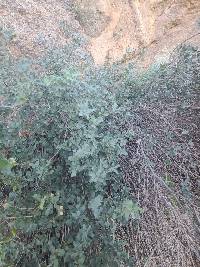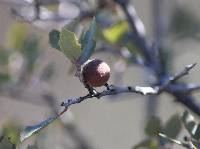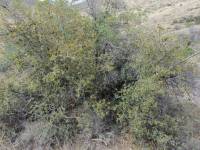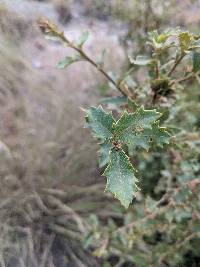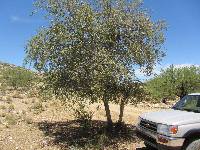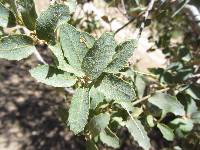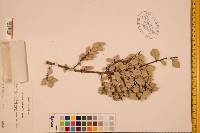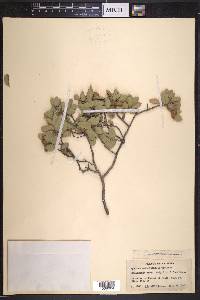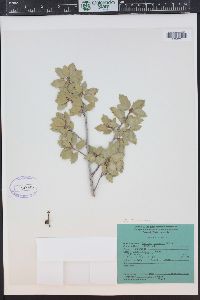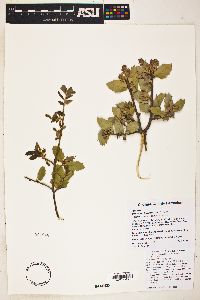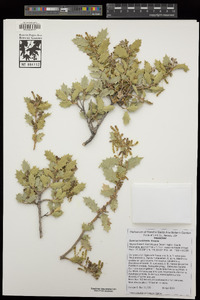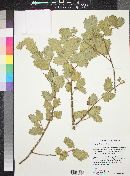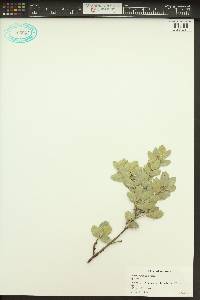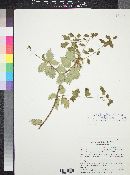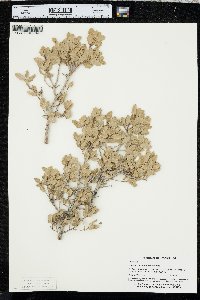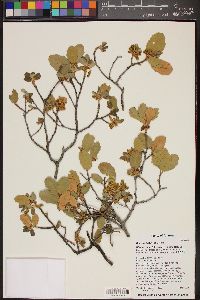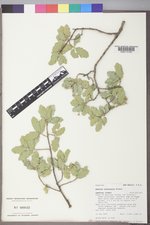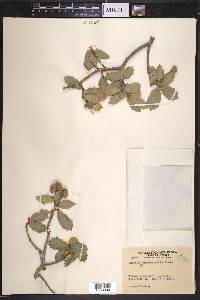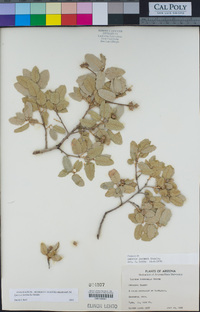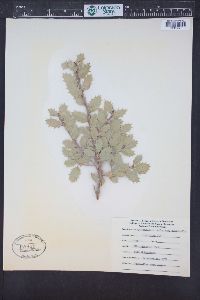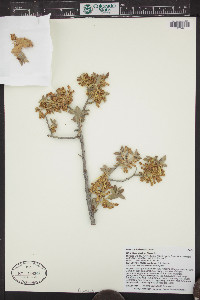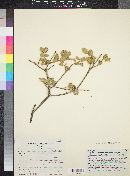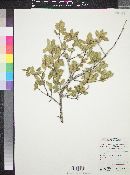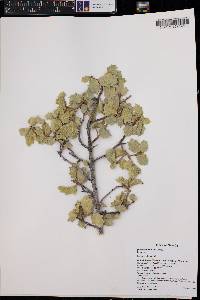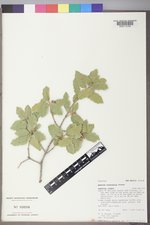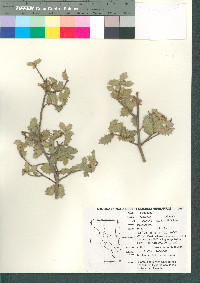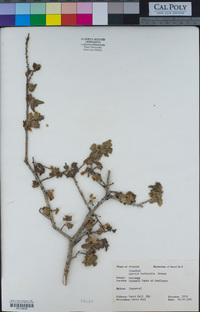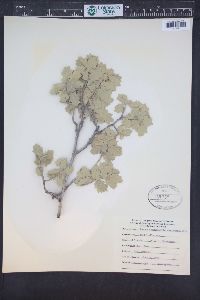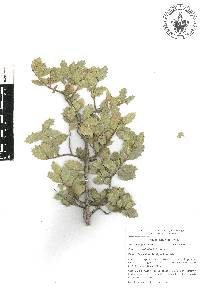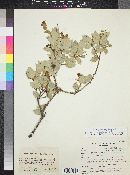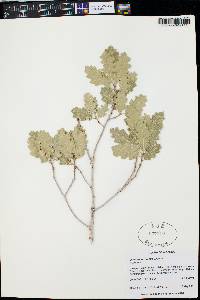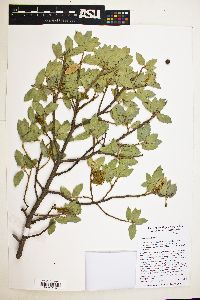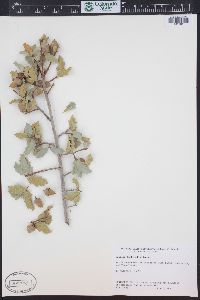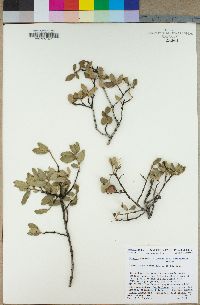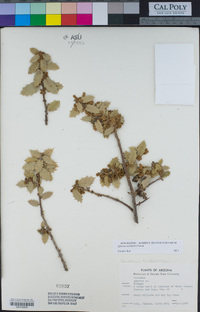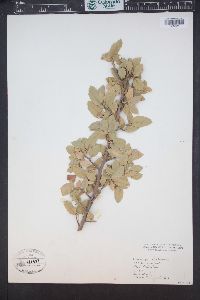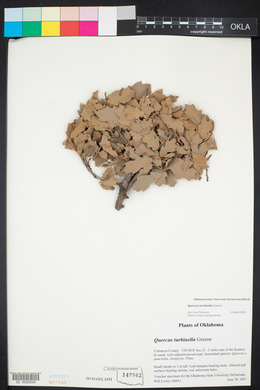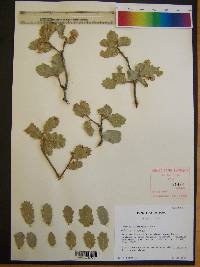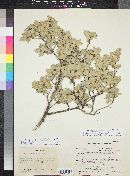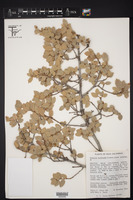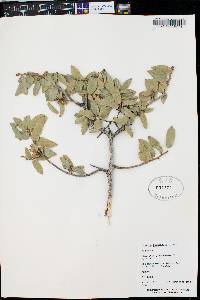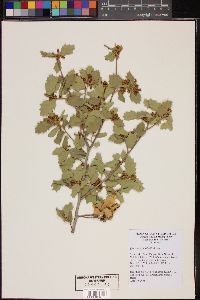Quercus turbinella
|
|
|
|
Family: Fagaceae
Arizona shrub oak, more...Shrub Live Oak, turbinella oak, desert scrub oak, scrub oak, Sonoran scrub oak (es: encinillo)
[Quercus dumosa var. turbinella (Greene) Jepson, moreQuercus subturbinella Trel.] |
Shrubs or small trees , evergreen or subevergreen, to 4 m. Bark light gray or brown, scaly. Twigs brown to gray, 1-3 mm diam., usually tomentulose, sometimes glabrous, becoming glabrate. Buds brown, round to ovoid, 1-2 mm, minutely pubescent. Leaves: petiole 1-4 mm. Leaf blade elliptic or ovate, (1.5-)20-30 × (5-)10-15(-20) mm, thick, leathery, base cordate or rounded, margins planar or slightly crisped-undulate, coarsely 3-5-toothed or very shallowly lobed on each side, teeth spinose with spines 1-1.5 mm, secondary veins 4-8 on each side, apex acute or obtuse; surfaces abaxially yellow or reddish, usually glaucous, minutely stellate-puberulent, adaxially grayish, glaucous, or yellowish glandular, glabrous or sparsely and minutely stellate-pubescent. Acorns solitary or several, on axillary peduncle 10-40 mm; cup hemispheric or shallowly cup-shaped, 4-6 mm deep × 8-12 mm wide, covering 1/4-1/2 nut, scales tightly appressed, ovate, moderately tuberculate, grayish or yellowish puberulent; nut light brown, ovoid, to 20 × 11 mm, minutely puberulent or glabrate. Cotyledons distinct. Flowering spring. Dry desert slopes, often in juniper and pinyon woodlands; 800-2000 m; Ariz., Calif., Colo., N.Mex., Nev., Tex., Utah; Mexico (Baja California, Sonora, and probably n Chihuahua). Formerly, California populations of what here is referred to as Quercus john-tuckeri have been included in the concept of Q . turbinella . Quercus john-tuckeri has subsessile fruit and noncordate leaf bases as opposed to the consistently pedunculate fruit and strongly cordate leaf bases of Q . turbinella . The two species seem to be no more closely related to each other than each might be to other southwestern oaks, and Q . john-tuckeri shares at least as many characteristics with Q . berberidifolia as with Q . turbinella . Thus, treatment of these two taxa as varieties of the same species is inappropriate. Quercus turbinella forms putative hybrid swarms with Q . gambelii (see treatment), as well as with Q . grisea .
Plant: shrub or small tree; 1-3(-6) m high, the bark light gray, rough, fissured; young twigs densely woolly (rarely glabrous) when young, smooth reddish-brown beneath hairs, the older twigs glabrescent, gray, sometimes blackened, remaining more or less smooth Leaves: unlobed, oblong-elliptic, ovate to suborbicular, 1.3-5.5(-6.5) cm long, 0.8-3(-4.5) cm wide, 1.3-2 times as long as wide, densely to sparsely covered with stellate and glandular hairs to glabrous below, moderately to sparsely covered with hairs to glabrous above, glabrescent with age, persisting 1-2 years; stellate hairs of lower leaf surface sometimes nearly scale-like, flattish, most with 7-13 arms; apex acute with sharp mucronate tip; base truncate to rounded; petiole 1-5 mm long, yellowish or reddish, moderately to densely covered with hairs; midvein nearly flat above, prominent below; lateral veins about 4-9 pairs, usually faint above, moderately prominent below; secondary veins forming a reticulate pattern above and below; blade usually bluish-green, coriaceous, more or less flat, dull or slightly lustrous above; margin with 1-8 sharply pointed, spinose teeth per side (rarely entire) INFLORESCENCE: staminate flowers in aments; pistillate flowers solitary or in groups on spikes, these sometimes abbreviated, each pistillate flower with a separate involucre Flowers: mostly wind-pollinated, unisexual, the perianth much reduced or absent; staminate flowers in heads or aments, the perianth greenish, the stamens 4-7; pistillate flowers usually tricarpellate, solitary or in clusters of about 3 or more, subtended individually or in groups by an involucre that develops into a woody cupule enclosing or subtending the mature fruit(s) Fruit: ACORNS 1.2-2.5 cm long, the peduncle 0-4 cm long; cap hemispheric, 5-8 mm long, 10-13 mm across, short woolly within; scales with thickened bases; nut-shell sparsely pilose within Misc: In chaparral, pinyon-juniper, and transitions between these and grasslands or desert; 600-2300 m (2000-7600 ft); Mar-Jun (fr. Jul-Sep) REFERENCES: Landrum, Leslie R. Fagaceae. 1994. J. Ariz. - Nev. Acad. Sci. Volume 27, 203-214 Landrum 1994, Wiggins 1964, Benson and Darrow 1981, Kearney and Peebles 1969 Common Name: Sonoran scrub oak Duration: Perennial Nativity: Native Lifeform: Shrub General: Shrub or small contorted tree, 1-3 m tall, tending to form thickets; bark light gray, rough, fissured; young twigs densely woolly, smooth, reddish-brown beneath the hairs; older twigs mostly hairless, gray, still more or less smooth. Leaves: Evergreen, persisting 1-2 years; alternate and short-petiolate; blades oblong-elliptic to suborbicular, 1-5 cm long and 1-3 cm wide, 1.3-2 times as long as wide; margin with 1-8 pointed teeth; slightly gray-green on upper surface and dull green below; surfaces glabrous, or covered with stellate and glandular hairs when young and becoming glabrascent with age. Flowers: Monoeceous (male and female flowers on the same plant), minute, and lacking petals; male flowers in catkins 1-3 cm long, with 5-lobed calyx and 5-10 stamens; female flowers solitary, with a 6 lobed calyx and 3 styles. Fruits: Acorns solitary or several, 1-2.5 cm long, elliptic, yellowish brown; with a scaly, shallow cup enclosing one-quarter to one-third of the nut. Ecology: Found on arid slopes, often among chaparral communities, from 2,000-8,000 ft (610-2438 m); flowers March-June. Notes: This is the common scrub oak of the middle elevations in the Southwest. Hybridizes with Q. grisea and Q. gambelii. Distinguish from Q. grisea based on its shorter, shrublike stature and sharp marginal teeth on the leaves (Q. grisea is more tree-like and has leaves with mostly smooth margins), as well as the stellate hairs on the leaf underside. In Q. turbinella, the hairs are more starfish like with radiating arms, and in Q. grisea the hairs have ascending arms. Ethnobotany: Used to make flour, bread, stew, mush, snack food, and the wood was used. Etymology: Quercus is the classical Latin word for oak, thought to be derived from Celtic quer, fine, and cuez, tree; turbinella is thought to mean shaped like a spinning top, perhaps in diminutive form. Synonyms: Quercus dumosa var. turbinella Editor: SBuckley 2010, AHazelton 2017 |
|
|
|

